Chirality is the geometric property of a group of points or atoms in space, or of a solid object, of not being superimposable on its mirror image. These structures, defined as chiral, have the peculiar property of being devoid of symmetry elements of the second kind, namely, a mirror plane, an center of inversion, or a rotation-reflection.
The definition of chirality, from the Greek cheir meaning “hand”, is due to Lord Kelvin who enunciated it during the “Baltimore Lectures”, a series of lectures held at Johns Hopkins University in Baltimore, starting from October 1st 1884, and published twenty years later, in 1904.
The environment is rich in chiral objects: your hands are the example par excellence, but there are many others, from the shell of a snail to a spiral galaxy. In chemistry, and especially in organic chemistry, chirality is a property of primary importance, because molecules such as carbohydrates, many amino acids, as well as many drugs, are chiral.
Chiral molecules can exist in two forms, mirror images of each other and non-superimposable, namely, there is no combination of rotations or translations on the plane of the sheet that allows their superposition. Such molecules are called enantiomers, from the Greek enántios, meaning “opposite” and meros,meaning “part”.
The most common cause of chirality in a molecule is the presence of a chirality center or chiral center, also called asymmetric center, namely, an atom that bears a set of atoms or functional groups in a spatial arrangement so that the resulting molecule can exist as two enantiomers.
Enantiomers are a kind of stereoisomers, that, in turn, can be defined as isomers having the same number and kind of atoms and bonds, but differing in the spatial orientation of the atoms.
Contents
Enantiomers
Two enantiomers of a chiral molecule, being non-superimposable, are different compounds. How do they differ?
Each pair of enantiomers has identical physical and chemical properties towards achiral properties, such as melting point, boiling point, refractive index, infrared spectrum, the solubility in the same solvent, or the same reaction rate with achiral reagents.
The differences emerge when they interacts with chemical and physical phenomena that have chiral properties.
- From the chemical point of view, two enantiomers can be distinguished by the way they interact with chiral structures, such as the binding site of a chiral receptor or the active site of a chiral enzyme.
- From the physical point of view, they differ in their interaction with plane-polarized light, that has chiral properties, namely, they have optical activity.
Chirality and optical activity
The optical activity of materials such as quartz and, more importantly, of organic compounds such as sugars or tartaric acid, was discovered in 1815 by the French scientist Jean-Baptiste Biot.
Chiral molecules can be classified based on the direction in which, from the observer’s point of view, plane-polarized light is rotated when it passes through a solution containing them.
- If a solution containing one enantiomer rotates plane-polarized light in a clockwise direction, the molecule is called dextrorotatory or dextrorotary, from the Latin dexter, meaning “right”, and is designated by the prefixes (+)-, or d– from dextro-.
- If a solution containing one enantiomer rotates plane-polarized light in a counterclockwise direction, the molecule is called levorotatory or levorotary, from the Latin laevus, meaning “left”, and is designated by the prefixes (-), or l– from laevo-.
Obviously, if we consider a pair of enantiomers, one is dextrorotatory and the other levorotatory.
At present it is not possible to reliably predict the magnitude, direction, or sign of the rotation of plane-polarized light caused by an enantiomer. On the other hand, the optical activity of a molecule provides no information on the spatial arrangement of the chemical groups attached to the chirality center.
Note: a system containing molecules that having the same chirality sense is called enantiomerically pure or enantiopure.
Pasteur and the discovery of enantiomers
In 1848, thirty three years after Biot’s work, studies on the optical activity of molecules led Louis Pasteur, who had been a student of Biot, to note that, following the recrystallization of a concentrated aqueous solution of sodium ammonium tartrate, optically inactive, two kinds of crystals precipitated, that were non-superimposable mirror images of each other.
After separating them with tweezers, Pasteur discovered that the solutions obtained by dissolving equimolar amounts of the two kind of crystals were optically active and, interestingly, the rotation angle of plane-polarized light was equal in magnitude but opposite in sign. Because the differences in optical activity were due to the dissolved sodium ammonium tartrate crystals, Pasteur hypothesized that the molecules themselves should be non-superimposable mirror images of each other, like their crystals. They were what we now call enantiomers. And it is Pasteur who first used the term asymmetry to describe this property, then called chirality by Lord Kelvin.
Racemic mixtures
A solution containing an equal amount of each member of a pair of enantiomers is called racemic mixture or racemate. These solutions are optically inactive: there is no net rotation of plane-polarized light since the amount of dextrorotatory and levorotatory molecules is exactly the same.
Unlike what happens in biochemical processes, the chemical synthesis of chiral molecules that does not involve chiral reactants, or that is not followed by methods of separation of enantiomers, inevitably leads to the production of a racemic mixture.
The pharmaceutical chemistry is among the sectors most affected by this. As previously mentioned, two enantiomers are different compounds. Many chiral drugs are synthesized as racemic mixtures. However, most often the desired pharmacological activity resides in one enantiomer, called eutomer; the other, called distomer, is less active or inactive. An example is ibuprofen, an arylpropionic acid derivative, and anti-inflammatory drug: only the S enantiomer, so named based on the nomenclature system called the RS system, has the pharmacological activity.
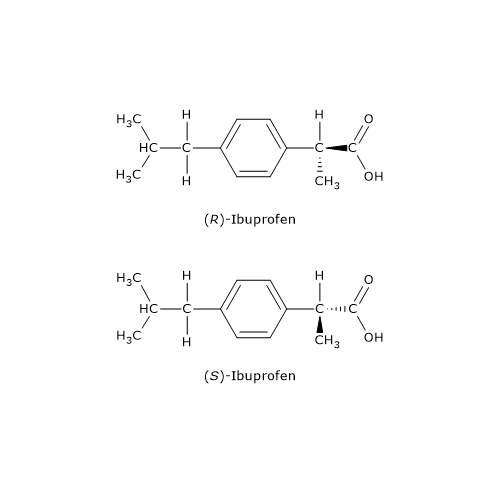
Arylpropionic derivatives are sold as racemic mixtures: a racemase converts the distomer to the eutomer in the liver.
However, it is also possible that the distomer causes harmful effects and must be eliminated from the racemic mixture. A tragic example is thalidomide, a sedative and anti-nausea drug sold as a racemic mixture from the 1950s until 1961, and taken also during pregnancy.
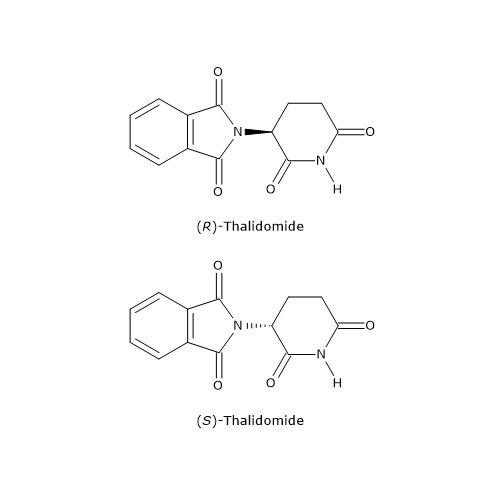 The distomer, the S enantiomer, could cause serious birth defects, particularly phocomelia. This is probably the most striking example of the importance of the chiral properties of molecules, which prompted health care organizations to promote the synthesis of drugs, including thalidomide, containing a single enantiomer by the pharmaceutical industry.
The distomer, the S enantiomer, could cause serious birth defects, particularly phocomelia. This is probably the most striking example of the importance of the chiral properties of molecules, which prompted health care organizations to promote the synthesis of drugs, including thalidomide, containing a single enantiomer by the pharmaceutical industry.
Chirality centers
Any tetrahedral atom that bears four different substituents can be a chirality center.
Carbon atom is the classic example, but also other atoms from group IVA of the periodic table, such as the semimetals silicon and germanium, have a tetrahedral arrangement and can be chiral centers. Another example is the phosphorus atom in organic phosphate esters that has a tetrahedral arrangement, then, when it binds four different substituents it is a chiral center.
The nitrogen atom of a tertiary amine, an amine in which the nitrogen is bounded to three different groups, is a chiral center. In these compounds, nitrogen is located at the center of a tetrahedron and its four sp3 hybrid orbitals point to the vertices, three of which are occupied by the three substituents, whereas the nonbonding electron pair points towards the fourth.
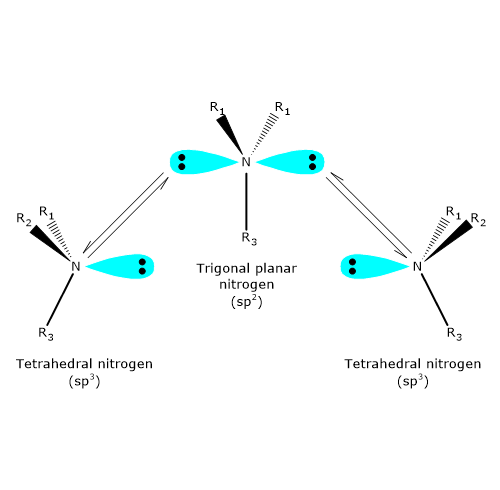 At room temperature, nitrogen rapidly inverts its configuration. The phenomenon is known as nitrogen inversion, namely, a rapid oscillation of the atom and its ligands, during which nitrogen passes through a planar sp2-hybridized transition state. As a consequence, if the nitrogen atom is the only chiral center of the molecule, there is no optical activity because a racemic mixture exists. The inversion of configuration does not occur only in some cases in which nitrogen is part of a cyclic structure that prevents it. Therefore, the presence of a chiral center could be not sufficient to allow the separation of the respective enantiomers.
At room temperature, nitrogen rapidly inverts its configuration. The phenomenon is known as nitrogen inversion, namely, a rapid oscillation of the atom and its ligands, during which nitrogen passes through a planar sp2-hybridized transition state. As a consequence, if the nitrogen atom is the only chiral center of the molecule, there is no optical activity because a racemic mixture exists. The inversion of configuration does not occur only in some cases in which nitrogen is part of a cyclic structure that prevents it. Therefore, the presence of a chiral center could be not sufficient to allow the separation of the respective enantiomers.
Note: in 1874, Jacobus Henricus van ‘t Hoff and Joseph Achille Le Bel, based on the work of Pasteur, first formulated the theory of the tetrahedral carbon atom. For this work van ‘t Hoff received the first Nobel Prize in chemistry in 1901.
Chirality in the absence of a chiral center
Chirality can also occur in the absence of a chiral center, due to the lack of free rotation around a double or a single bond, as in the case of:
- allene derivatives, organic compounds in which there are two cumulative double bonds, namely, two double bonds localized on the same carbon atom;
- biphenyl derivatives.
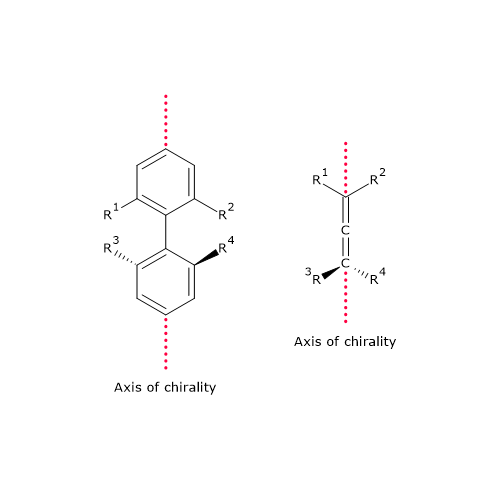 In this case, chirality is due to the presence of an axis of chirality.
In this case, chirality is due to the presence of an axis of chirality.
Meso compounds
Meso compounds are stereoisomers with two or more chiral centers that are superimposable on their mirror image, then achiral and, as such, optically inactive. Moreover, they have an internal mirror plane that bisects the molecule, with each half a mirror image of the other. Then, meso compounds can be classified as diastereomers, namely, stereoisomers which are not enantiomers.
For a molecule with n chirality centers, the maximum number of possible stereoisomers is 2n.
Consider 2,3-butanediol. The molecule has two chirality centers, the carbons 2 and 3. Therefore, there are 22 = 4 possible stereoisomers, whose structures are depicted in the figure, in the Fischer projections, indicated as A, B, C, D.
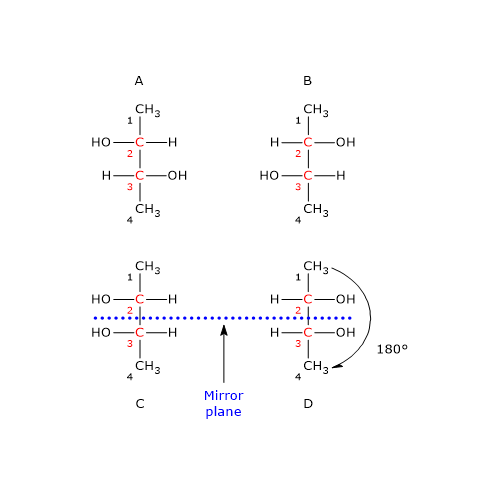
Structures A and B are mirror images of each other and non-superimposable, then they are a pair of enantiomers.
Structures C and D are mirror images of each other, but are superimposable. In fact, if we rotate structure C or D of 180 degrees, the two structures are superimposable. Then, they are not a pair of enantiomers: they are the same molecule with opposite orientation. Moreover, they have an internal mirror plane, that bisects the molecule, giving two halves, each a mirror image of the other. Structure C, or D, is therefore a meso compound because it has chiral centers, is superimposable on its mirror image, and has internal mirror plane that divides the molecule into two mirror‐image halves.
References
- Capozziello S. and Lattanzi A. Geometrical approach to central molecular chirality: a chirality selection rule. Chirality 2003;15:227-230. doi:10.1002/chir.10191
- Garrett R.H., Grisham C.M. Biochemistry. 4th Edition. Brooks/Cole, Cengage Learning, 2010
- IUPAC. Compendium of Chemical Terminology, 2nd ed. (the “Gold Book”). Compiled by A. D. McNaught and A. Wilkinson. Blackwell Scientific Publications, Oxford (1997). Online version (2019-) created by S. J. Chalk. ISBN 0-9678550-9-8. doi:10.1351/goldbook
- Kelvin WT. Baltimore lectures on molecular dynamics and the wave theory of light. Clay C. J., London: 1904:619. https://archive.org/details/baltimorelecture00kelviala/mode/2
- Voet D. and Voet J.D. Biochemistry. 4th Edition. John Wiley J. & Sons, Inc. 2011